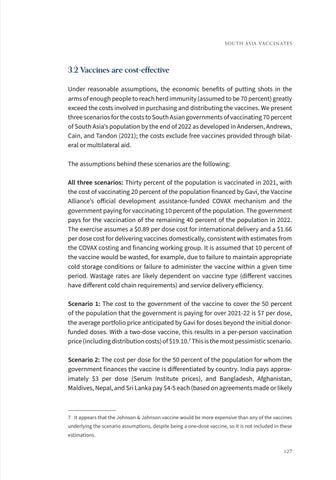S o u t h A s i a Va c c i n a t e s
3.2 Vaccines are cost-effective Under reasonable assumptions, the economic benefits of putting shots in the arms of enough people to reach herd immunity (assumed to be 70 percent) greatly exceed the costs involved in purchasing and distributing the vaccines. We present three scenarios for the costs to South Asian governments of vaccinating 70 percent of South Asia’s population by the end of 2022 as developed in Andersen, Andrews, Cain, and Tandon (2021); the costs exclude free vaccines provided through bilateral or multilateral aid. The assumptions behind these scenarios are the following: All three scenarios: Thirty percent of the population is vaccinated in 2021, with the cost of vaccinating 20 percent of the population financed by Gavi, the Vaccine Alliance’s official development assistance-funded COVAX mechanism and the government paying for vaccinating 10 percent of the population. The government pays for the vaccination of the remaining 40 percent of the population in 2022. The exercise assumes a $0.89 per dose cost for international delivery and a $1.66 per dose cost for delivering vaccines domestically, consistent with estimates from the COVAX costing and financing working group. It is assumed that 10 percent of the vaccine would be wasted, for example, due to failure to maintain appropriate cold storage conditions or failure to administer the vaccine within a given time period. Wastage rates are likely dependent on vaccine type (different vaccines have different cold chain requirements) and service delivery efficiency. Scenario 1: The cost to the government of the vaccine to cover the 50 percent of the population that the government is paying for over 2021-22 is $7 per dose, the average portfolio price anticipated by Gavi for doses beyond the initial donorfunded doses. With a two-dose vaccine, this results in a per-person vaccination price (including distribution costs) of $19.10.7 This is the most pessimistic scenario. Scenario 2: The cost per dose for the 50 percent of the population for whom the government finances the vaccine is differentiated by country. India pays approximately $3 per dose (Serum Institute prices), and Bangladesh, Afghanistan, Maldives, Nepal, and Sri Lanka pay $4-5 each (based on agreements made or likely
7 It appears that the Johnson & Johnson vaccine would be more expensive than any of the vaccines underlying the scenario assumptions, despite being a one-dose vaccine, so it is not included in these estimations. 127




